Signal Analysis, Signal Demodulation and Numerical Simulation of a Quasi-Distributed Optical Fiber Sensor Based on FDM/WDM Techniques and Fabry-Pérot Interferometers
Abstract
:1. Introduction
2. Optical System and its Reflection Spectrum
3. Frequency Spectrums
4. Sensor Conditions
5. Signal Demodulation
6. Numerical Results and Discussion
6.1. Parameters
6.2. Reflection Spectrum
6.3. Frequency Spectrum
6.4. Numerical Results
6.5. Discussion
7. Conclusions
Author Contributions
Funding
Conflicts of Interest
References
- Grattan, K.T.V.; Sun, T. Fiber optic sensor technology: An overview. Sens. Actuators 2000, 82, 40–61. [Google Scholar] [CrossRef]
- Kashyap, R. Photosensitive Optical Fibers: Device and Applications. Opt. Fiber Technol. 1994, 1, 17–34. [Google Scholar] [CrossRef]
- Cao, D.; Fang, H.; Wang, F.; Zhu, H.; Sun, M. A fiber Bragg-Grating-Based Miniature Sensor for the Fast Detection of Soil Moisture Profiles in Highway Sloped and Subgrades. Sensors 2018, 18, 4431. [Google Scholar] [CrossRef] [PubMed]
- Li, W.; Yuan, Y.; Yang, J.; Yuan, L. In-fier integrated quasi-distributed high temperature sensor array. Opt. Express 2018, 26, 34113–34121. [Google Scholar] [CrossRef] [PubMed]
- Huang, J.; Zhou, Z.; Zhang, L.; Chen, J.; Ji, C.; Pham, T. Strain Model Analysis of Small and Light Pipes Using Distributed Fibre Grating Sensors. Sensors 2016, 16, 1583. [Google Scholar] [CrossRef] [PubMed]
- Ben Zaken, B.B.; Zanzury, T.; Maka, D. An 8-Channel Wavelength MMI Demodultiplexer in Slot Waveguide Structures. Materials 2016, 9, 881. [Google Scholar] [CrossRef] [PubMed]
- Cibula, E.; Donlagic, D. I-line short cavity Fabry-Perot strain sensor for quasi-distributed measurement utilizing standard OTDR. Opt. Express 2007, 15, 87198730. [Google Scholar] [CrossRef]
- Wezinger, S.; Bergdolt, S.; Engelbrecht, T.; Schmauss, B. Quais-Distributed Fiber Bragg Grating Sensing Using Stepped Incoherent Optical Frequency Domain Reflectometry. J. Lightwave Technol. 2016, 34, 5270–5277. [Google Scholar] [CrossRef]
- Weng, Y.; Ip, E.; Pan, Z.; Wang, T. Advances Spatial-Division Multiplexing Measurement Systems Propositions-From Telecommunications to Sensing Applications: A Review. Sensors 2016, 16, 1387. [Google Scholar] [CrossRef]
- Nazmi, A.M.; Hatem, O.E. Ultra-sensitive quasi-distributed temperature sensor based on an apodized fiber Bragg grating. Appl. Opt. 2018, 57, 273–282. [Google Scholar]
- Shlyagin, M.G.; Miridonov, S.V.; Tentori Santa-Cruz, D. Frequency multiplexing of in-fiber Bragg grating sensors using tunable laser. In Proceedings of the Conference on Micro-optical technologies for measurement, Sensors and Microsystems II and Optical Sensor Technologies and Applications, Munich, Germany, 24 September 1997; Volume 3099, p. 6. [Google Scholar]
- Shlyagin, M.G.; Miridonov, S.V.; Márquez Borbón, I.; Spirin, V.V.; Swart, P.L.; Chcherbakov, A. Multiplexing twin-Bragg grating interferometer sensor. In Proceedings of the Optical Fiber Sensors Conference Technical Digest (OFS 2002), Portland, OR, USA, 6–10 May 2002; pp. 191–194. [Google Scholar]
- Della Tamin, M.; Meyer, J. Quasi-Distributed Fabry-Perot Optical Fibre Sensor for Temperature Measurement. IEEE Access 2018, 6, 66235–66242. [Google Scholar] [CrossRef]
- Liu, J.; Lu, P.; Mihailov, S.J.; Wang, M.; Yao, J. Real-time random grating sensor array for quasi-distributed sensing based on wavelength-to-time mapping and time-division multiplexing. Opt. Lett. 2019, 44, 379–382. [Google Scholar] [CrossRef] [PubMed]
- Li, X. Simultaneous wavelength and frequency encoded microstructure based quasi-distributed temperature sensor. Opt. Express 2012, 20, 12076–12084. [Google Scholar] [CrossRef] [PubMed]
- Guillen Bonilla, J.T.; Guillen Bonilla, A.; Rodríguez Betancourtt, V.M.; Guillen Bonilla, H.; Casillas Zamora, A. A Theoretical Study and Numerical Simulation of a Quasi-Distributed Sensor Based on the Low-Finnesse Fabry-Perot Interferometer: FrequencyDivision Multiplexing. Sensors 2017, 17, 859. [Google Scholar] [CrossRef] [PubMed]
- Guillen Bonilla, J.T.; Guillen Bonilla, H.; Casillas Zamora, A.; Vega Gómez, G.A.; Franco Rodríguez, N.E.; Guillen Bonilla, A.; Reyes Gómez, J. Twin-gratin Fiber Optic Sensors Applied on Wavelength-Division Multiplexing and its Numerical Resolution. In Numerical Simulation in Engineering and Science, 1st ed.; Rao, S., Ed.; IntechOpen: London, UK, 2018; pp. 179–195. ISBN 978-1-78923-451-0. [Google Scholar]
- Miridonov, S.V.; Shlyagin, M.G.; Tentori, D. Twin grating fiber optic sensor demodulation. Opt. Commun. 2001, 191, 253–262. [Google Scholar] [CrossRef]
- Miridonov, S.V.; Shlyagin, M.G.; Tentori, D. Digital demodulation of Twin-Grating Fiber-Optic sensor. In Proceedings of the SPIE Conference on Distributed and Multiplexed Fiber Optic Sensors VII, Boston, MA, USA, 5–7 September 1999; Volume 3541, pp. 271–278. [Google Scholar] [CrossRef]
- Miridonov, S.V.; Shlyagin, M.G.; Spirin, V.V. Resolution limits and efficient signal processing for fiber optic Bragg grating with direct spectroscopic detection. In Proceedings of the SPIE Conference on Optical Measurement Systems for Industrial Inspection III, Munich, Germany, 23–26 June 2003; Volume 5144. [Google Scholar] [CrossRef]
- Wang, Y.; Gong, J.; Wang, D.Y.; Dong, B.; Bi, W.; Wang, A. A quasi-distributed sensing network with time division multiplexing. IEEE Photonics Technol. Lett. 2010, 23, 70–72. [Google Scholar] [CrossRef]
- Shlyagin, M.G.; Miridonov, S.V.; Diana Santa-Cruz, D.; Mendieta Jiménez, F.J.; Spirin, V.V. Multiplexing of grating-based fiber sensors using broadband spectral coding. In Proceedings of the Conference on Fiber Optic and Laser Sensors and Applications, Boston, MA, USA, 1 November 1998; Volume 3541, pp. 271–277. [Google Scholar]
- Yuksel, K.; Wuilpart, M.; Moeyaert, V.; Mégret, P. Optical Frequency Domain Reflectometry: A Review. In Proceedings of the 11th International Conference on Transparent Optical Networks, Azores, Portugal, 28 June–2 July 2009. [Google Scholar] [CrossRef]
- Dolfi, D.W. High-resolution optical frequency domain reflectometry. In Proceedings of the Optical Fiber Communication Conference, San Diego, CA, USA, 18 February 1991. [Google Scholar] [CrossRef]
- MacDonald, R.I. Frequency domain optical reflectometer. Appl. Opt. 1981, 20, 1840–1844. [Google Scholar] [CrossRef] [PubMed]
- Nakayama, J.; Lizuka, K.; Mielsen, J. Optical fiber fault locator by the step frequency method. Appl. Opt. 1987, 26, 440–443. [Google Scholar] [CrossRef] [PubMed]
- Dolfi, D.W.; Nazarathy, M.; Newton, S.A. 5-mm-resolution optical-frequency-domain-reflectometry using a coded phase-reversal modulator. Opt. Lett. 1988, 13, 678–680. [Google Scholar] [CrossRef] [PubMed]
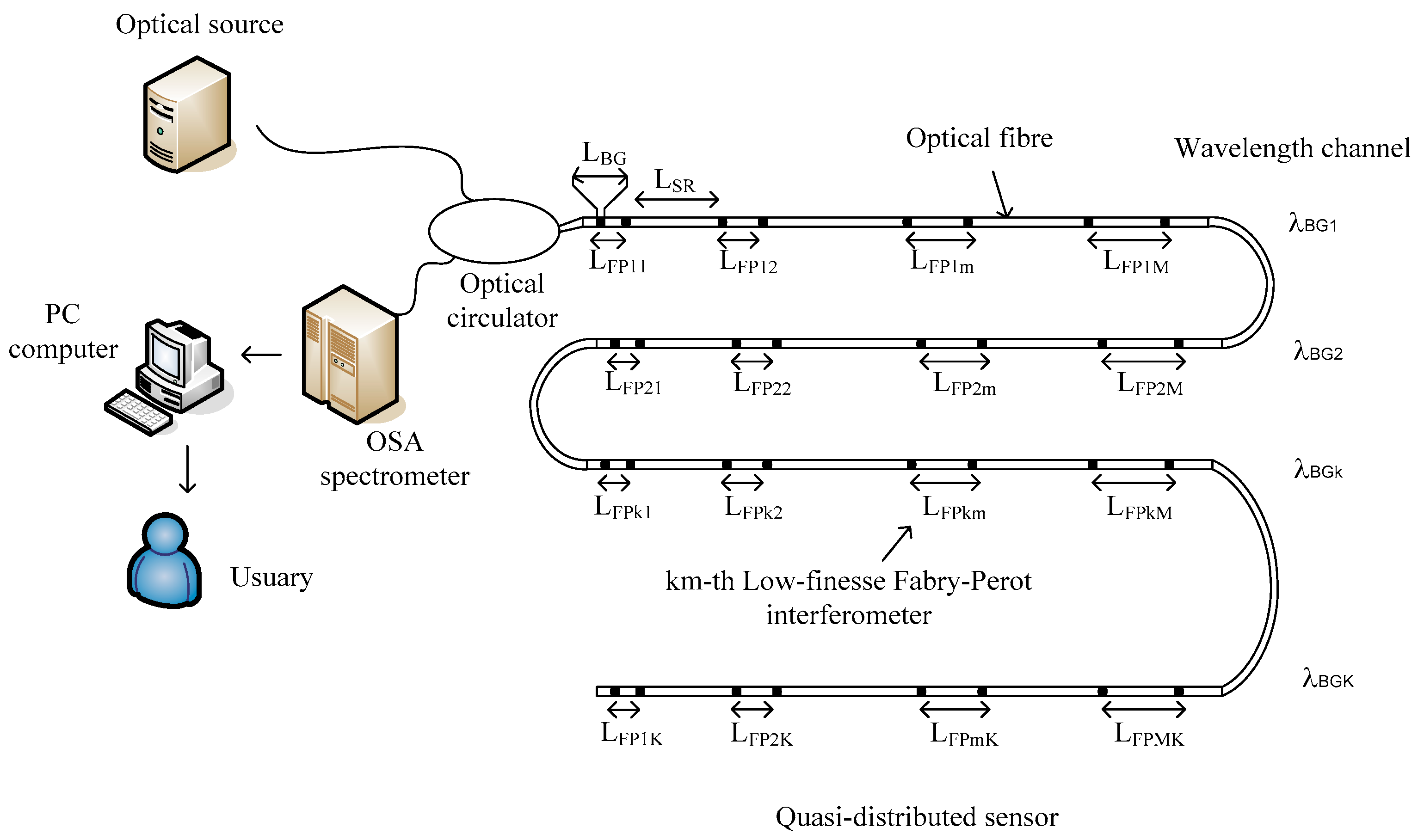
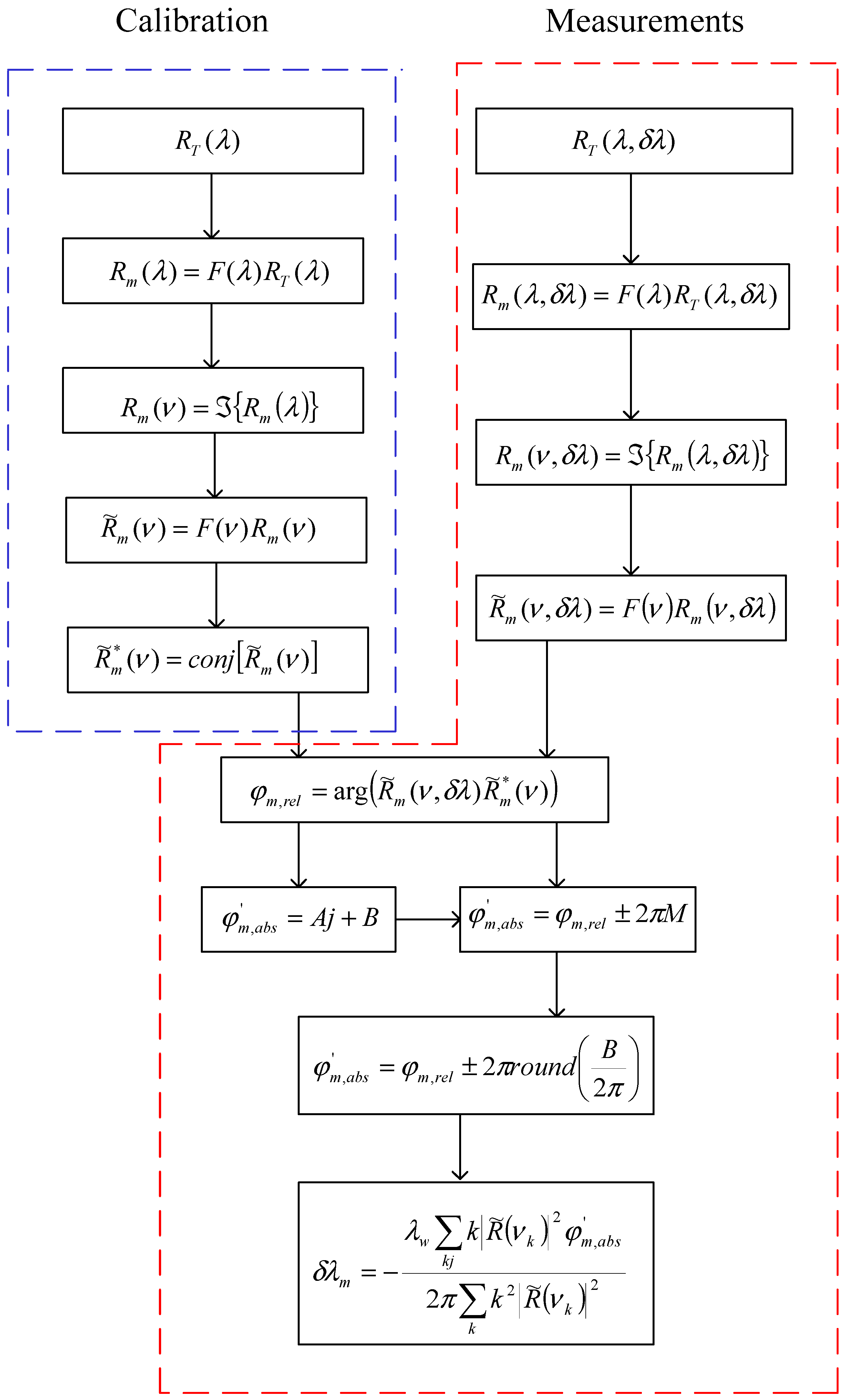
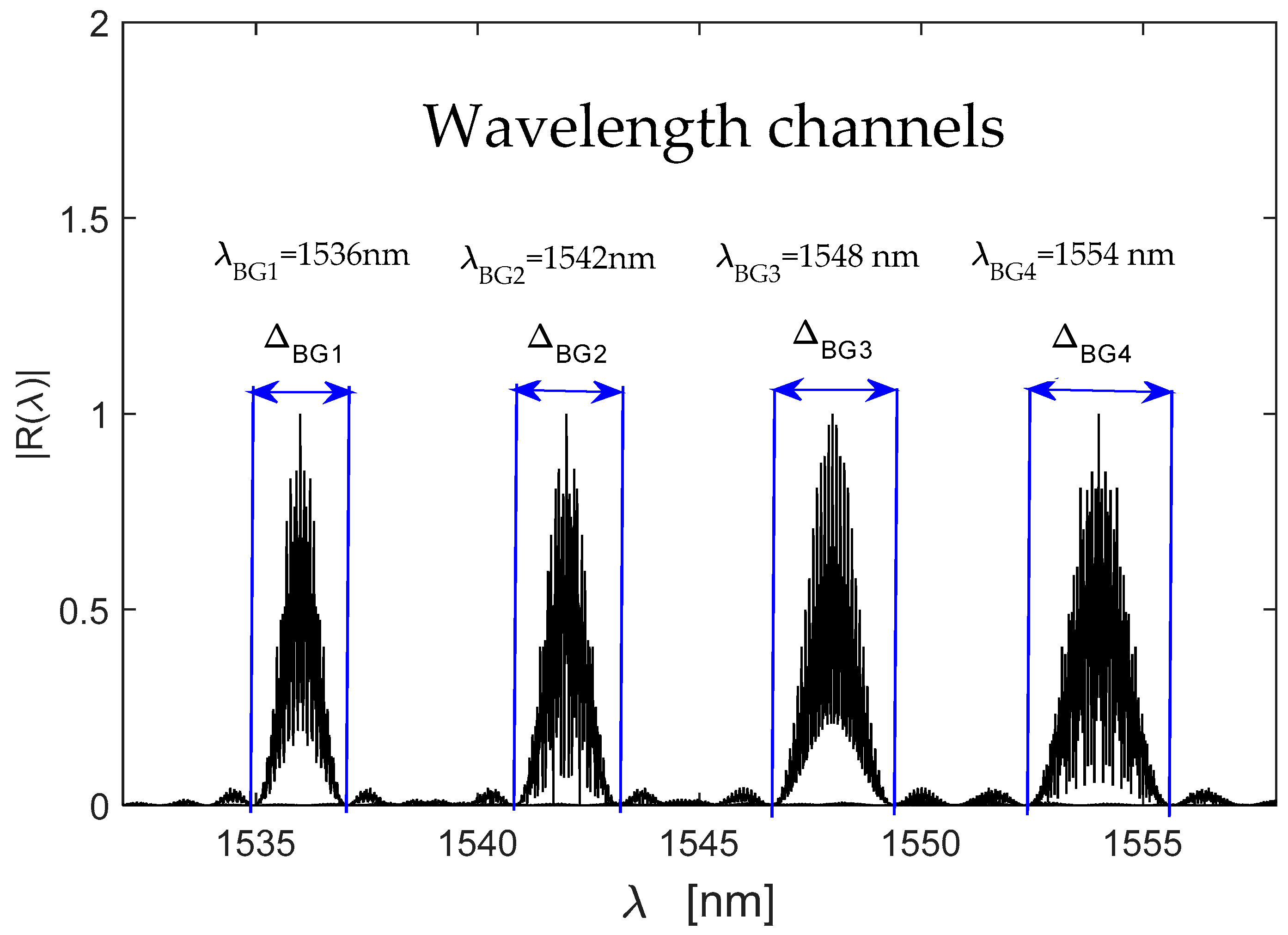
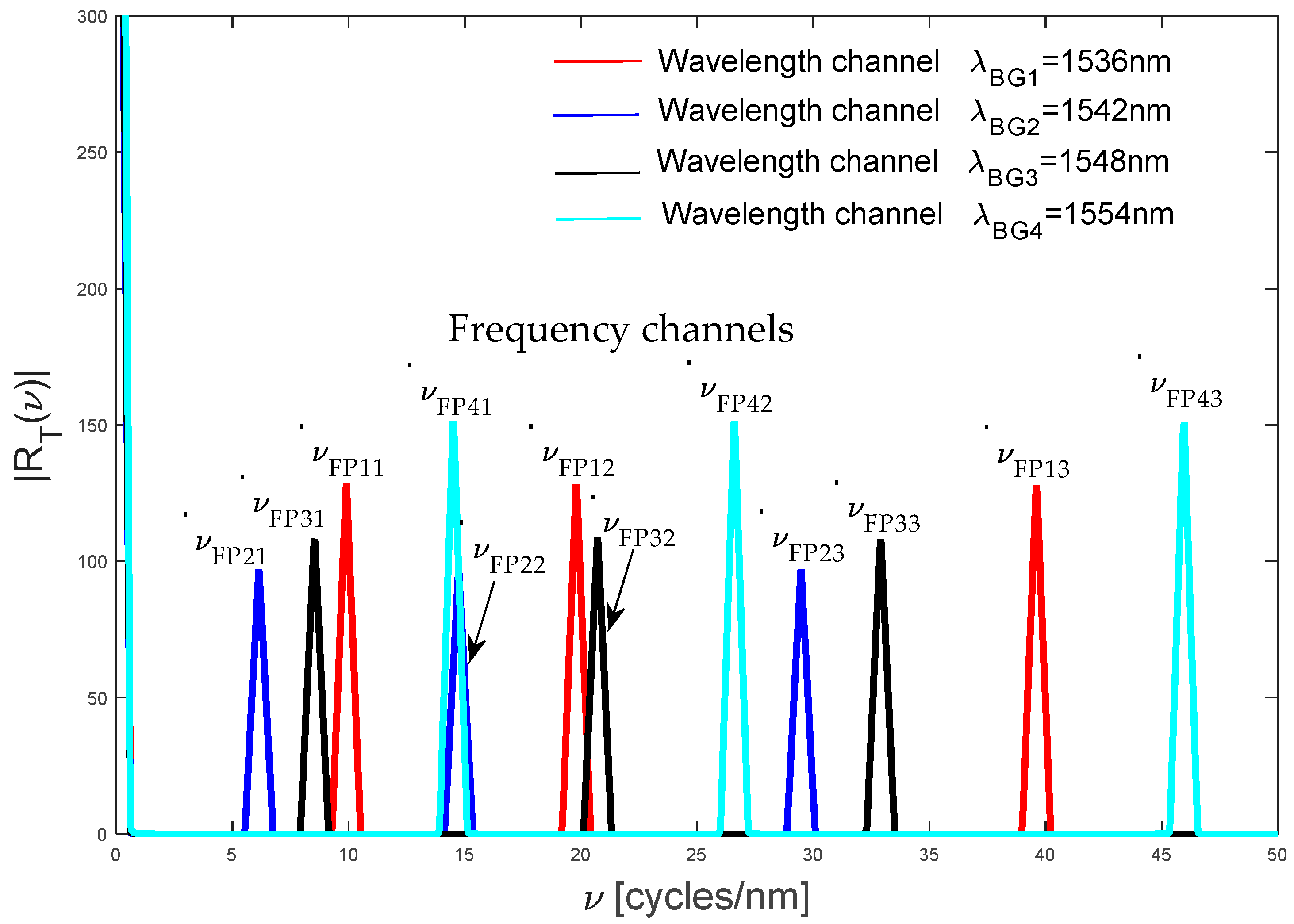
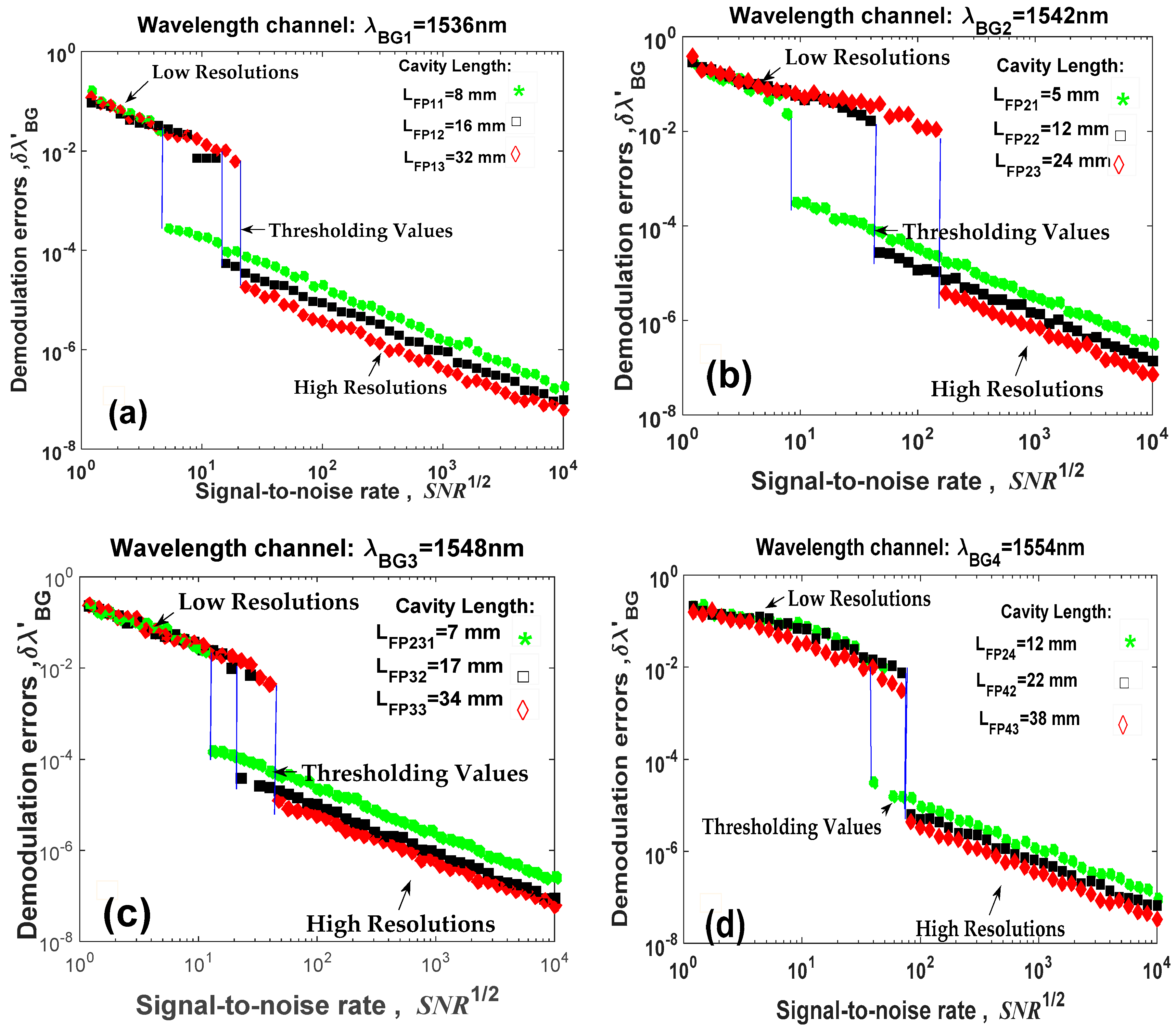
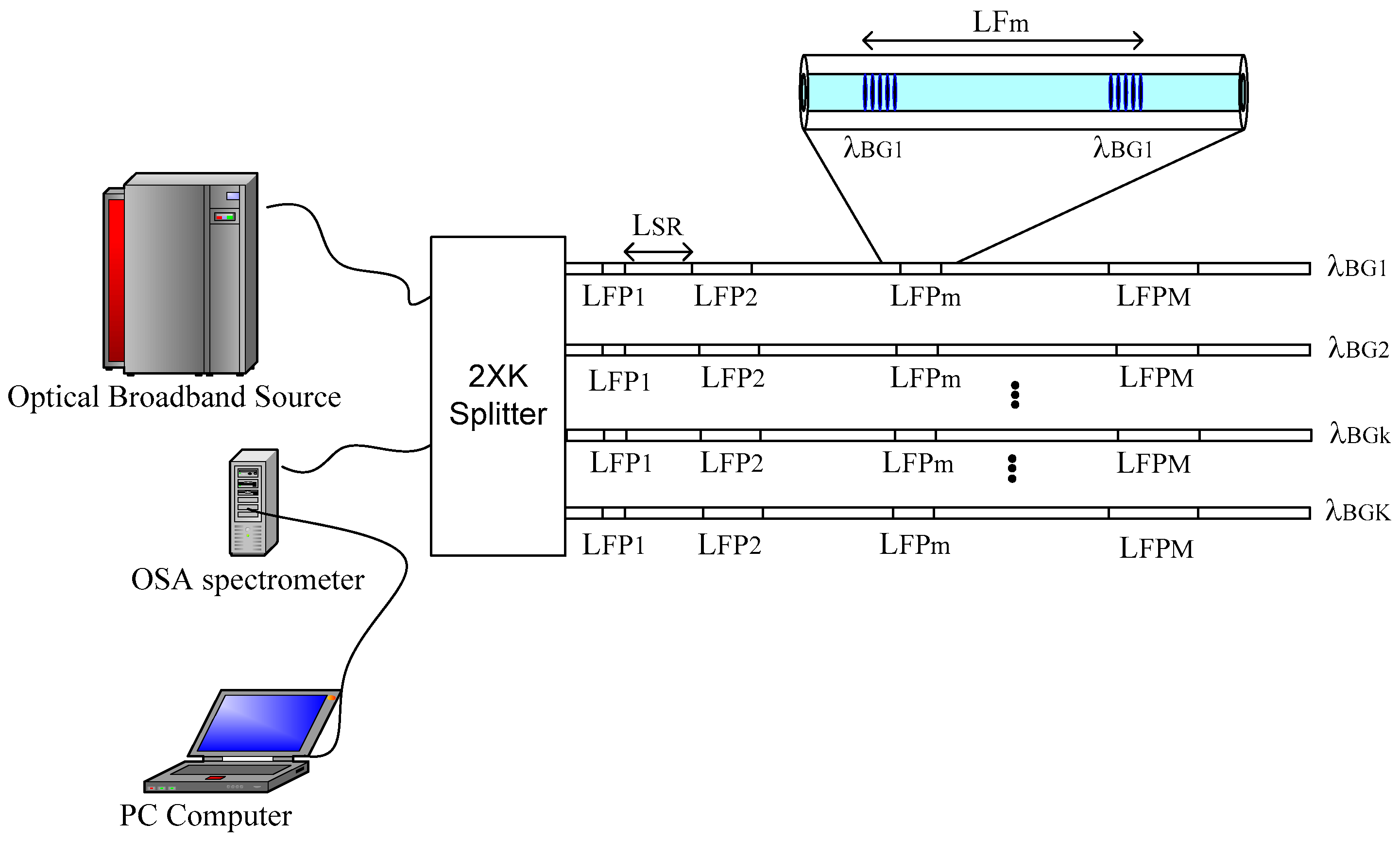
| Wavelength Channel | Frequency Channel | Fabry-Pérot Sensors Parameters | ||
|---|---|---|---|---|
| Channel k | Value [nm] | Channel m | Value [Cycles/nm] | |
| 1 | 1536 | 1 | n = 1.46 | |
| LFP11 = 8 mm | ||||
| LBG = 0.5 mm | ||||
| 2 | n = 1.46 | |||
| LFP12 = 16 mm | ||||
| LBG = 0.5 mm | ||||
| 3 | n = 1.46 | |||
| LFP13 = 32 mm | ||||
| LBG = 0.5 mm | ||||
| 2 | 1542 | 1 | n = 1.46 | |
| LFP21 = 5 mm | ||||
| LBG = 0.5 mm | ||||
| 2 | n = 1.46 | |||
| LFP22 = 12 mm | ||||
| LBG = 0.5 mm | ||||
| 3 | n = 1.46 | |||
| LFP23 = 24 mm | ||||
| LBG = 0.5 mm | ||||
| 3 | 1548 | 1 | n = 1.46 | |
| LFP31 = 7mm | ||||
| LBG = 0.5mm | ||||
| 2 | n = 1.46 | |||
| LFP32 = 17 mm | ||||
| LBG = 0.5 mm | ||||
| 3 | n = 1.46 | |||
| LFP33 = 27 mm | ||||
| LBG= =.5 mm | ||||
| 4 | 1554 | 1 | n = 1.46 | |
| LFP41 = 12 mm | ||||
| LBG = 0.5 mm | ||||
| 2 | n = 1.46 | |||
| LFP42 = 22mm | ||||
| LBG = 0.5 mm | ||||
| 3 | n = 1.46 | |||
| LFP43 = 38 mm | ||||
| LBG = 0.5 mm | ||||
| Wavelength Channel | Frequency Channel | Displacement Applied to Each Fabry-Pérot Sensor, | |
|---|---|---|---|
| Fabry-Pérot Sensor | Value [nm] | Channel m (Value) | |
| 1536 | 1 (9.90) | 0–0.2 | |
| 2 (19.80) | 0–0.4 | ||
| 3 (39.60) | 0–0.8 | ||
| 1542 | 1 (6.14) | 0–0.32 | |
| 2 (14.73) | 0–0.24 | ||
| 3 (29.47) | 0–0.85 | ||
| 1548 | 1 (8.52) | 0–0.57 | |
| 2 (20.71) | 0–0.12 | ||
| 3 (32.90) | 0–0.28 | ||
| 1554 | 1 (14.50) | 0–0.7 | |
| 2 (26.60) | 0–0.23 | ||
| 3 (45.94) | 0–0.77 | ||
| Parameter | Value | Equation |
|---|---|---|
| 16 [wavelength channels] | Equation (3) | |
| 40 [Frequency channels] | Equation (3) | |
| 640 [Fabry-Pérot sensors] | Equation (3) | |
| Equation (16) | ||
| Equation (17) | ||
| Equation (18) |
| Local Sensors, | Parameter | Local Sensors, | Parameter |
|---|---|---|---|
© 2019 by the authors. Licensee MDPI, Basel, Switzerland. This article is an open access article distributed under the terms and conditions of the Creative Commons Attribution (CC BY) license (http://creativecommons.org/licenses/by/4.0/).
Share and Cite
Guillen Bonilla, J.T.; Guillen Bonilla, H.; Rodríguez Betancourtt, V.M.; Casillas Zamora, A.; Sánchez Morales, M.E.; Gildo Ortiz, L.; Guillen Bonilla, A. Signal Analysis, Signal Demodulation and Numerical Simulation of a Quasi-Distributed Optical Fiber Sensor Based on FDM/WDM Techniques and Fabry-Pérot Interferometers. Sensors 2019, 19, 1759. https://doi.org/10.3390/s19081759
Guillen Bonilla JT, Guillen Bonilla H, Rodríguez Betancourtt VM, Casillas Zamora A, Sánchez Morales ME, Gildo Ortiz L, Guillen Bonilla A. Signal Analysis, Signal Demodulation and Numerical Simulation of a Quasi-Distributed Optical Fiber Sensor Based on FDM/WDM Techniques and Fabry-Pérot Interferometers. Sensors. 2019; 19(8):1759. https://doi.org/10.3390/s19081759
Chicago/Turabian StyleGuillen Bonilla, José Trinidad, Héctor Guillen Bonilla, Verónica María Rodríguez Betancourtt, Antonio Casillas Zamora, María Eugenia Sánchez Morales, Lorenzo Gildo Ortiz, and Alex Guillen Bonilla. 2019. "Signal Analysis, Signal Demodulation and Numerical Simulation of a Quasi-Distributed Optical Fiber Sensor Based on FDM/WDM Techniques and Fabry-Pérot Interferometers" Sensors 19, no. 8: 1759. https://doi.org/10.3390/s19081759
APA StyleGuillen Bonilla, J. T., Guillen Bonilla, H., Rodríguez Betancourtt, V. M., Casillas Zamora, A., Sánchez Morales, M. E., Gildo Ortiz, L., & Guillen Bonilla, A. (2019). Signal Analysis, Signal Demodulation and Numerical Simulation of a Quasi-Distributed Optical Fiber Sensor Based on FDM/WDM Techniques and Fabry-Pérot Interferometers. Sensors, 19(8), 1759. https://doi.org/10.3390/s19081759






